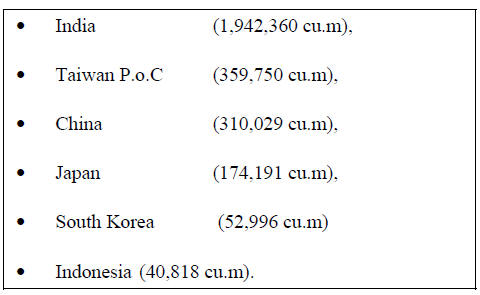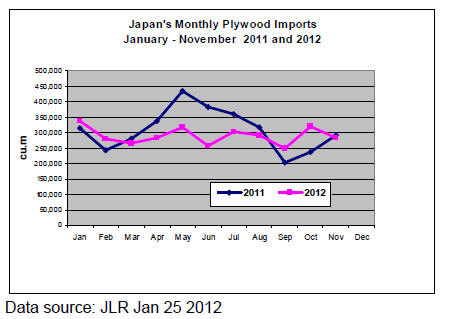Japan Wood Products
Prices
Dollar Exchange Rates of
25th January 2013
Japan Yen
90.87
Reports From Japan
Economy remains relatively weak
The Bank of Japan (BoJ) Monetary Policy Board held a meeting on January 21
and 22, and released its assessment of the Japanese economy. The following
two main points are emphasized in the BoJ press release.
Exports and industrial production have declined mainly due to the fact
that overseas economies remain in a deceleration
phase.
Business fixed investment in Japan has shown some weakness, but resilience
has been observed in the non-manufacturing sector.
In contrast, public investment has continued to increase and housing
investment has picked up. Private consumption has remained resilient and the
decline in car sales, due to the ending of some measures to stimulate
demand, has diminished.
Economic outlook from the Bank of Japan
Japan's economy is not expected to deteriorate any further. The economy is
expected to return to a moderate recovery path as domestic demand remains
resilient.
This will be achieved through government economic measures and through
recovery of overseas demand as the major economies gradually recover.
Exports are expected to continue to fall but at a reduced pace in the short
term. Eventually, says the BoJ, exports will pick up as overseas economies
gradually strengthen.
Public investment is expected to continue trending upward supported by the
effects of various economic measures and housing investment is expected to
continue to pick up. Some improvement in domestic demand is anticipated.
Private sector fixed investment is projected to remain relatively weak for
the time being, especially in the manufacturing sector, but to eventually
follow a moderately upward trend partly due to investment related to
disaster prevention and energy. Private consumption is expected to remain
resilient.
As a reflection of these developments in demand, both at home and abroad,
industrial output is projected to stop falling and then start recovering.
However, there remains a high degree of uncertainty about the pace at which
the global economy can improve.
For the BoJ statement see :
http://www.boj.or.jp/en/mopo/gp_2013/gp1301a.pdf
Consumers remain cautious
The Japanese consumer confidence index dropped in December as consumers
weigh the economic policies and proposals of the new government.
The consumer confidence survey shows the number of people who think prices
will rise over the next 12 months (59.6 percent of respondents) remained
unchanged from the previous month. The policies of the new Liberal
Democratic Party government are yet to have an impact on consumer price
expectations.
The survey also assessed sentiment on incomes and jobs, which fell to 39.2
in December 2012 only marginally changed for the 39.4 recorded in November
2012. A reading below 50 suggests consumer pessimism.
The quarterly survey by the Bank of Japan indicates that over 50% of those
polled expect prices to be higher a year ahead however, about 40 % indicated
that they expect prices to remain largely unchanged over the next 12 months.
Defending the weakening of the yen
As recent data is showing that Japan's exports fell more than expected,
there have been more demands from the private sector for the government to
take action to further weaken the yen.
Compared to the export performance in the same month a year earlier, Japan’s
exports fell almost 6 percent last month driving the trade deficit to a
record 7 trillion yen.
A weaker yen has the potential to boost exports but raises the cost of
imports and Japan needs to import more energy resources to ensure a stable
power supply since almost all the nuclear power plants in the country have
been shut down for safety checks.
Economists in many countries have voiced concern that the deliberate
weakening of the yen could spark a regional currency war. In response to
this the head of the BoJ said the bank was not targeting a competitive
devaluation but rather a devaluation to fight deflation.
Over the past 3 months the yen that has weakened about 8 percent against the
US dollar and on the 25th January crossed the 90 yen to the dollar level.
Some analysts expect the government and the BoJ to work together to push the
yen to 100 to the dollar.

From the Japan Lumber Reports:
1. Housing starts projection for 2013
2. South Sea (tropical) log trade
3. Trends in the plywood market
Housing starts projection for 2013
The Japan Forest Products Journal made a survey last December on this year’s
housing starts.
According to the replies from 15 major house builders, an average starts are
920,000 units. Incidentally, the projection for last year was 870,000 units
so this year’s
starts would be 5.7% up from last year.
Regarding increase of consumption tax to 8% from current 5% from April next
year, which is the most impacting factor this year, it is hard to foresee
the impact because there are no definite measures yet of tax incentive for
house purchase at this stage although many forecast increase of housing
starts this year before the tax increase.
When the consumption tax was increased from 3% to 5% in April of 1997,
housing starts in 1998 dropped by 28% compared to the starts in 1996, which
were 1,630,000 units.
The general view of the housing industry is that orders would be up by 10%
then the drop off after the tax increase would be 20%.

South Sea logs
Heavy rain continues in Malaysia, which hinders transportation of logs
together with log production. Local plywood mills struggle to secure enough
logs with declining inventories.
Export log prices have not climbed so sharply as India keeps log purchase
composedly but bullish mood continues.
Proposed prices on Sarawak meranti regular are about $260 per cbm FOB but
actual prices are about $255. Meranti small prices are $215-220 and super
small are $195-200.
Sabah also suffers foul weather and kapur prices are firm at about $363 and
firming due to log shortage.
Ocean freight rate is also up by $1 per cbm since January 1. All those
factors of higher FOB, increasing freight and weakening yen are cost push
factors.
Log prices in Japan are gradually climbing as the log importers need to
cover inflated cost by weak yen.
Meranti regular prices are 8,000 yen per koku CIF, 200-300 yen higher than
December. Kapur regular prices are 11,200 yen, 300-400 yen up. Even if FOB
prices remain unchanged, yen cost would be up by 400-500 yen.
Plywood market
The market for both domestic and imported plywood is firm. Shipment of
domestic softwood plywood for precutting plants and major house builders was
active in January and the manufacturers give priority to such direct users
so that deliveries for wholesalers and retailers now take more than two
weeks.
The manufacturers carry orders through to mid February so they have started
allocating the volume for trading firms since mid January.
Secondary dealers buy from primary wholesalers at high prices in tight
supply.
Current market prices of 12 mm 3 x6 (special type/F 4 star) are 780 yen per
sheet delivered, 30 yen up from December. since January 21 the manufacturers
started taking orders at 800 yen.
Long panel of 9 mm 3x10 prices are 1,200 yen, 20-30 yen up and thick panel
of 24 mm 3x6 prices are 1,600-1,650 yen, 30-40 yen up.
Imported plywood market prices are rapidly climbing with weakening yen and
sizable price hike by the largest plywood supplier in Malaysia, Shenya for
January shipment.
Their proposal is 45,000 yen per cbm C&F on 3x6 JAS concrete forming panel,
which is 4,000 yen higher than December price. Considering rapid progressing
depreciation of the yen, yen based purchase may be safer.
Importers have started pushing the prices up in Japan market as future
arrivals would cost much higher.
Current prices are 920 yen on 3x6 JAS concrete forming panel, 30-40 yen up
from December. 1,070-1,100 yen on JAS 3x6 concrete forming for coating,
40-50 yen up. 970 yen on 12 mm structural panel, 50 yen up.
Trading firms say that those prices are not high enough to cover future
arrivals so they need to go higher yet but gradual hike is preferable as the
market may stall if the prices go up without supporting demand.

|